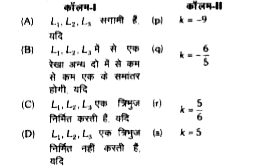यदि x+1x=2cosθ , तो x का मान होगा (1)cosθ+isinθ (2)cosθ−isinθ (3)cosθ±isinθ (4)sinθ±icosθ
cosθ+isinθ
cosθ−isinθ
cosθ±isinθ
sinθ±icosθ
The correct Answer is:C
Step by step video, text & image solution for यदि x+1/x=2costheta , तो x का मान होगा (1)cos theta+ isintheta (2)costheta-isintheta (3)costhetapmisintheta (4)sinthetapmicostheta by Maths experts to help you in doubts & scoring excellent marks in Class 12 exams.
Updated on:21/07/2023Topper's Solved these Questions
- सम्मिश्र संख्यायेंBook:ERRORLESS HINDIChapter:सम्मिश्र संख्यायेंExercise:Solved Multiple Choice Questions (सम्मिश्र संख्याओं का संयुग्मी, मापांक तथा कोणांक)
Explore 55 Videos
- सम्मिश्र संख्यायेंBook:ERRORLESS HINDIChapter:सम्मिश्र संख्यायेंExercise:Solved Multiple Choice Questions (सम्मिश्र संख्याओं का वर्गमूल, निरूपण और लघुगणक)
Explore 9 Videos
- सम्मिश्र संख्यायेंBook:ERRORLESS HINDIChapter:सम्मिश्र संख्यायेंExercise:Jee Advanced (Integer)
Explore 9 Videos
- समुच्चय सिद्धान्त तथा सम्बन्ध Book:ERRORLESS HINDIChapter:समुच्चय सिद्धान्त तथा सम्बन्ध Exercise:JEE Advanced (Reasoning type questions)
Explore 3 Videos
- सरल रेखा Book:ERRORLESS HINDIChapter:सरल रेखा Exercise:JEE ADVANCE (Matrix Match type questions)
Explore 4 Videos
Similar Questions
सम्मिश्र संख्याएँ sinx+icos2x तथा cosx−isin2x
x के किस मान के लिये एक दूसरे की संयुग्मी हैं
View Solutionयदि (−7−24i)1/2=x−iy, तो x2+y2=
View Solutionमान लीजिए कि z कोई सम्मिश्र संख्या है जिसके लिये |z−3−2i|≤2 सत्य है, तो |2z-6+5i| का न्यूनतम मान है
View Solutionमाना R वास्तविक संख्याओं का समुच्चय है
कथन-1 : A={(x,y)∈R×R:y−x एक पूर्णांक है} R पर एक तुल्यता संबंध है |
कथन-2 : B={(x,y)∈R×R:x=αy किसी परिमेय संख्या α के लिए} R पर एक तुल्यता संबंध है |
View Solution
View SolutionIf θ is real then the modulus of 11+cosθ+isinθ is
View Solutionx+iy=11+cosθ+isinθ,then 4x2=
View SolutionIf 32+cosθ+isinθ=x+iy then (x-1)(x-3)=
View Solution1−cosθ+isinθ1+cosθ−isinθ
View Solution(1+cosθ+isinθ1+cosθ−isinθ)n
View Solution(1+cosθ+isinθ)n+(1+cosθ−isinθ)n
View SolutionIf θ=π/6 then the 10th term of the series 1+(cosθ+isinθ)+(cosθ+isinθ)2+...... is
View SolutionProve that (1+cosθ+isinθ)n+(1+cosθ−isinθ)n=2n+1cosn(θ2)cos(nθ2)
View SolutionIf a=cos theta +isintheta Then (1+a)/(1-a) =
View Solution(1+cosθ−isinθ)4=
View SolutionAssertion (A) : (Cosθ+iSinθ)10+(Cosθ−iSinθ)10=2cos10θ
Reason (R) : (1+cosθ+isinθ)n+(1+cosθ−isinθ)n=
2n+1cosn(θ2)cos(nθ2)
View Solution